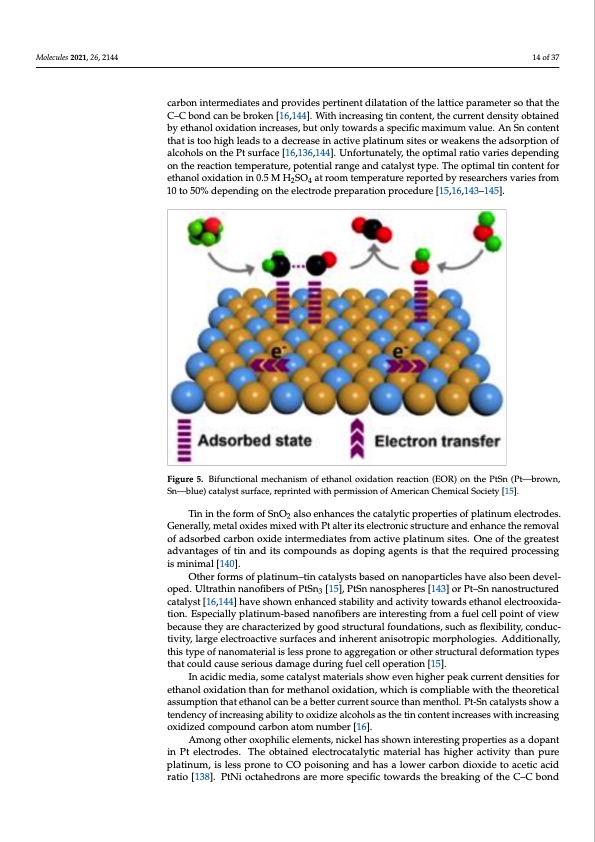
PDF Publication Title:
Text from PDF Page: 014
Molecules 2021, 26, 2144 14 of 37 carbon intermediates and provides pertinent dilatation of the lattice parameter so that the C–C bond can be broken [16,144]. With increasing tin content, the current density obtained by ethanol oxidation increases, but only towards a specific maximum value. An Sn content that is too high leads to a decrease in active platinum sites or weakens the adsorption of alcohols on the Pt surface [16,136,144]. Unfortunately, the optimal ratio varies depending on the reaction temperature, potential range and catalyst type. The optimal tin content for ethanol oxidation in 0.5 M H2SO4 at room temperature reported by researchers varies from 10 to 50% depending on the electrode preparation procedure [15,16,143–145]. Figure 5. Bifunctional mechanism of ethanol oxidation reaction (EOR) on the PtSn (Pt—brown, Sn—blue) catalyst surface, reprinted with permission of American Chemical Society [15]. Tin in the form of SnO2 also enhances the catalytic properties of platinum electrodes. Generally, metal oxides mixed with Pt alter its electronic structure and enhance the removal of adsorbed carbon oxide intermediates from active platinum sites. One of the greatest advantages of tin and its compounds as doping agents is that the required processing is minimal [140]. Other forms of platinum–tin catalysts based on nanoparticles have also been devel- oped. Ultrathin nanofibers of PtSn3 [15], PtSn nanospheres [143] or Pt–Sn nanostructured catalyst [16,144] have shown enhanced stability and activity towards ethanol electrooxida- tion. Especially platinum-based nanofibers are interesting from a fuel cell point of view because they are characterized by good structural foundations, such as flexibility, conduc- tivity, large electroactive surfaces and inherent anisotropic morphologies. Additionally, this type of nanomaterial is less prone to aggregation or other structural deformation types that could cause serious damage during fuel cell operation [15]. In acidic media, some catalyst materials show even higher peak current densities for ethanol oxidation than for methanol oxidation, which is compliable with the theoretical assumption that ethanol can be a better current source than menthol. Pt-Sn catalysts show a tendency of increasing ability to oxidize alcohols as the tin content increases with increasing oxidized compound carbon atom number [16]. Among other oxophilic elements, nickel has shown interesting properties as a dopant in Pt electrodes. The obtained electrocatalytic material has higher activity than pure platinum, is less prone to CO poisoning and has a lower carbon dioxide to acetic acid ratio [138]. PtNi octahedrons are more specific towards the breaking of the C–C bondPDF Image | Effect of Anode Material on Electrochemical Oxidation of Alcohols

PDF Search Title:
Effect of Anode Material on Electrochemical Oxidation of AlcoholsOriginal File Name Searched:
molecules-26-02144.pdfDIY PDF Search: Google It | Yahoo | Bing
NFT (Non Fungible Token): Buy our tech, design, development or system NFT and become part of our tech NFT network... More Info
IT XR Project Redstone NFT Available for Sale: NFT for high tech turbine design with one part 3D printed counter-rotating energy turbine. Be part of the future with this NFT. Can be bought and sold but only one design NFT exists. Royalties go to the developer (Infinity) to keep enhancing design and applications... More Info
Infinity Turbine IT XR Project Redstone Design: NFT for sale... NFT for high tech turbine design with one part 3D printed counter-rotating energy turbine. Includes all rights to this turbine design, including license for Fluid Handling Block I and II for the turbine assembly and housing. The NFT includes the blueprints (cad/cam), revenue streams, and all future development of the IT XR Project Redstone... More Info
Infinity Turbine ROT Radial Outflow Turbine 24 Design and Worldwide Rights: NFT for sale... NFT for the ROT 24 energy turbine. Be part of the future with this NFT. This design can be bought and sold but only one design NFT exists. You may manufacture the unit, or get the revenues from its sale from Infinity Turbine. Royalties go to the developer (Infinity) to keep enhancing design and applications... More Info
Infinity Supercritical CO2 10 Liter Extractor Design and Worldwide Rights: The Infinity Supercritical 10L CO2 extractor is for botanical oil extraction, which is rich in terpenes and can produce shelf ready full spectrum oil. With over 5 years of development, this industry leader mature extractor machine has been sold since 2015 and is part of many profitable businesses. The process can also be used for electrowinning, e-waste recycling, and lithium battery recycling, gold mining electronic wastes, precious metals. CO2 can also be used in a reverse fuel cell with nafion to make a gas-to-liquids fuel, such as methanol, ethanol and butanol or ethylene. Supercritical CO2 has also been used for treating nafion to make it more effective catalyst. This NFT is for the purchase of worldwide rights which includes the design. More Info
NFT (Non Fungible Token): Buy our tech, design, development or system NFT and become part of our tech NFT network... More Info
Infinity Turbine Products: Special for this month, any plans are $10,000 for complete Cad/Cam blueprints. License is for one build. Try before you buy a production license. May pay by Bitcoin or other Crypto. Products Page... More Info
| CONTACT TEL: 608-238-6001 Email: greg@infinityturbine.com | RSS | AMP |